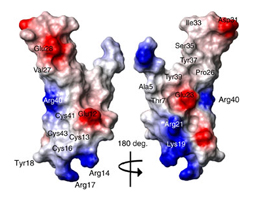Research Abstract
ストマジェンのNMR構造から明らかになった植物ペプチドホルモンによる気孔密度調節の基盤
The NMR structure of stomagen reveals the basis of stomatal density regulation by plant peptide hormones
2011年10月25日 Nature Communications 2 : 512 doi: 10.1038/ncomms1520

植物での気孔の発生は、デフェンシン様分泌型EPF(epidermal patterning factor)ペプチドホルモン群によって調節されている。これらのペプチドホルモン中ではストマジェンだけが正の調節因子で、EPF1、EPF2(それにおそらくはそのほかのホルモンも)は負の調節因子である。今回我々は、ストマジェンについてのNMRとセミin vitro実験での結果を統合して、EPF群の構造機能相関について調べた。ストマジェンは3つのジスルフィド結合を含む足場部分およびループからなる構造である。ストマジェンのループとEPF2の足場部分からなる変異体は、シロイヌナズナ(Arabidopsis)子葉で気孔密度を増やすように正に調節する。これとは逆に、EPF2のループとストマジェンの足場部分からなる変異体は、気孔の数を減らすような負の調節因子となる。ジスルフィド結合を除去するとタンパク質の折りたたみがほどけ、不活性になる。我々の結果は、EPFの機能的特異性はループによるものであり、足場はその活性の構造基盤として必要とされることを示している。機能部位を解明するための構造分解というこの手法は、システインに富むほかのペプチドファミリーの解析にも適用できると考えられる。
- 北陸先端科学技術大学院大学 ナノマテリアルテクノロジーセンター
- 石川県立大学 生物資源工学研究所 植物遺伝子工学研究室
Stomatal development in plants is regulated by defensin-like secretory epidermal patterning factor (EPF) peptide hormones. Only one of these, stomagen, is a positive regulator, whereas EPF1, EPF2, and possibly others are negative regulators. Here we explore the structure–function relationships of EPFs, by integrating NMR and semi-in vitro stomagen experiments. We show that stomagen is composed of a loop and a scaffold containing three disulphide bonds. A mutant composed of the stomagen loop and the EPF2 scaffold positively regulates the stomatal density on Arabidopsis cotyledons. The reciprocal mutant composed of the EPF2 loop and the stomagen scaffold acts negatively. Deletion of the disulphide bond introduces unfolding and inactivity. Our results suggest that the loop confers the functional specificity of EPFs and that the scaffold is structurally required for their activity. This structural decomposition approach to elucidating the functional site could be adapted for the analysis of other cysteine-rich peptide families.

